2022-11-21
How different could it be having a cat from having a dog? We would say- a lot. Both cats and dogs are individuals, who have different types of personalities. However, cats are considered species that are much more close to their wild ancestors than other domesticated species. You may have a cat, who is people-oriented, loves to cuddle, and constantly seeks your attention...or on the other hand, your cat may be quite intolerant towards living with people or other pets in the household. Also, some cats have kept their strong hunting instincts and would spend the whole day hunting prey instead of enjoying the delicious meal you have prepared for them.
We decided to dedicate this article to our feline friends and their owners. We will give you several tips on how to make your home to be more cat friendly, so your paw friend feels loved and taken care of.
Let’s begin with the cat’s primary needs, namely food.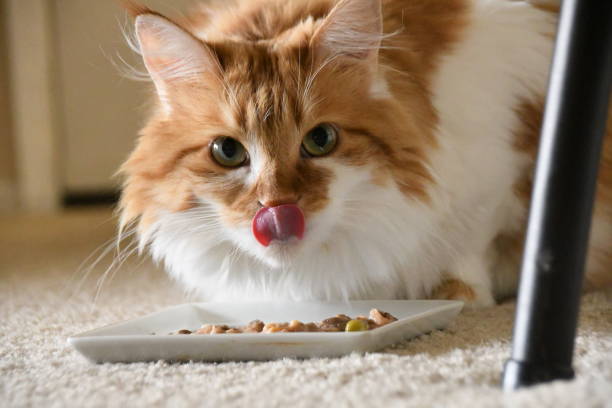
You should adapt your cat’s meal to his/her age, size, and breed. Kibbles for kittens are usually offered in a small size to make your kitty feel comfortable while eating. Also, you can find dry cat food adapted to cats who have been spayed/neutered, which is lower in fat. There are also many types of food, i.e. designed to protect your cat’s teeth, and skin, or specially adapted to cats with more sensitive stomachs. You should also be careful of the portions you feed your feline friend. Cats are highly food-motivated, and some individuals are prone to overeating. It is recommended that you divide your cat’s meal into small portions and provide these throughout the day or at least twice a day. It is essential for your cat’s comfort to keep a routine and feed your kitty at certain times during the day. In order to keep your cat on a healthy diet, you may want to mix dry and wet food. However, you should not let canned food stay for more than a few hours, as otherwise, the risk of bacteria developing will drastically increase.
When it comes to food bowls, your cat would not enjoy the feeling of her whiskers touching the bowl, so you want to opt for a bowl that is wide and not very deep. However, too flat bowls may also be a not very good option, as your kitty could push his/her food outside the bowl and make a mess. In regard to the bowl’s material-there are different options on the market, i.e. plastic, ceramic, glass, stainless steel...etc. Bowls made of stainless steel have proved easy to clean and sustainable. However, if your paw friend wears any training gear such as a leash, a collar, or an ID tag...he/she may not like the sound the bowl produces when this type of gear rubs against the bowl’s sides.
The location of the food bowl is also important. It should not be right next to your cat’s litter. It is preferable to place the bowl in a designated area that will be your cat’s eating place. This area should not be too isolated, i.e. in a basement, nor too crowded, i.e. in a hallway, and the place should be easy to access.
You can make feeding a pleasant and interesting experience for your cat, by providing him/her with puzzle feeders or toys with hidden treats inside. These toys will stimulate your feline friend to “hunt” his/her prey and stay mentally stimulated throughout the day.
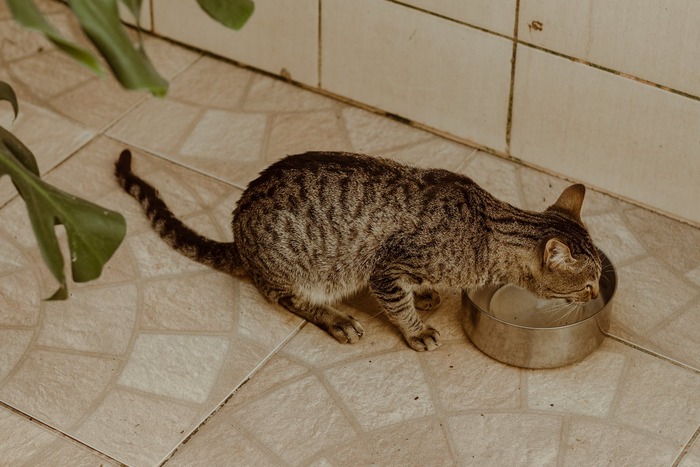
You should make sure that your kitty always has access to fresh water. Cats are not likely to drink a lot of water, however, you should never neglect to provide your cat with water supplies. Similar to the food bowl, you should not place your cat’s water bowl directly to his/her litter. You may have noticed that cats enjoy drinking water from the sink or places with flowing water. Buying your cat a fountain might be a good option as it will stimulate your kitty to drink water. Just like the food bowl, the water bowl should be placed in a quiet, but not isolated place, where your cat will feel safe and comfortable.
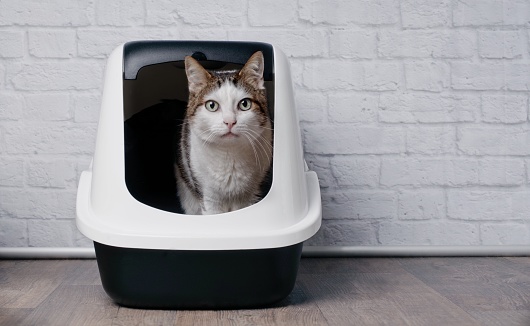
Litter trays are an absolute necessity for indoor cats. There are a few aspects to consider when it comes to litter trays-material, design, size, cleaning, number of litter trays in a household with more than one cat, and location.
When it comes to the material-there are several different options on the market such as clay, "pellets" and "crystals" (the latter are actually silica-based). Many owners (and also their kitties) prefer clay-based litters, due to their ability to absorb liquid. These litters produce clumps which makes scooping much easier. Also, there are different sizes and scents you can choose from. However, most of the litters on the market are lightweight and neutralize bad odors. So, you may not need to add extra substances to neutralize the odor. Moreover, any strong scents may repel your cat from using the litter box.
When talking about designs, you can opt for a litter tray that is open, covered, or closed. Of course, cat owners typically prefer closed litter boxes, as they prevent their cats from soiling the floor and any items on it, especially carpets. However, if your cat does not feel very comfortable relieving him/herself in a such confined space, you may need to consider getting an open litter tray or at least a litter tray that is not fully covered.
The litter box should not be too big or too small. Your cat should have enough space to move inside. It is considered that the perfect size of a litter box is 1.5 times the length of the cat that will use it.
It is important to remember that cats are clean creatures, and they may refuse to use a litter box, that has not been cleaned. We would recommend that you clean your kitty’s litter tray at least once a day, but preferably twice or three times a day.
If you have multiple cats in the household, you should have at least one litter box per cat. Some behaviorists even recommend that owners have one extra litter tray, so your cat/cats chose the one that suits their needs the most.
Talking about location, you may already know that the litter box should not be put directly next to your cat’s food or water bowl. Researchers state that you should not place a cat’s litter tray directly next to a full-length window, as they may feel threatened by factors in the outdoor surrounding. It should be placed in a separate area, where your kitty will have some privacy.
If your cat refuses to use a litter box, this might be caused by a certain trigger in the environment, a rapid change, or a health condition. If you have recently rearranged the furniture, changed your living location, or your cat’s routine, any of these factors may have caused stress in your kitty. However, if there were not any recent changes, you may need to pay attention to any sounds, smells, or environmental factors, that may have caused your cat to change his/her behavior. Also, you should always be cautious about the place your cat’s litter box is located.
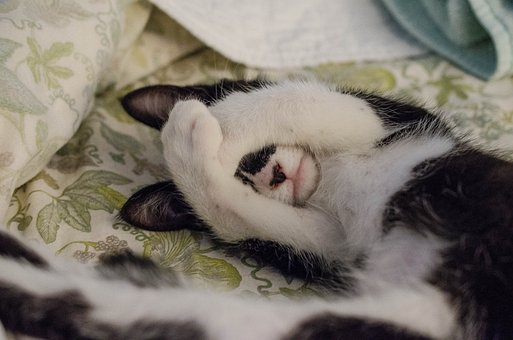
You may think: "Why should I buy a special bed for my cat, as he/she is likely to find a random box or an open drawer and go sleep there?" We can not argue with that. However, if you would make your home as comfortable for your kitty as possible, there are some things in regard to bedding you should consider.
Cats enjoy “preparing” their beds making a specific movement with their paws. The softer the “bed” is, the better. A warm plush blanket or a towel put on the furniture could perfectly work for this purpose. Also, your feline friend is likely to enjoy his/her bedding location to be near a radiator or in a quiet, warm, and some sort of hidden area, where he/she can rest and relax uninterrupted. Another factor that cats usually pay attention to when selecting their bedding spot, is their owner’s scent. They prefer places where there is a strong scent of the owner, as this provides a feeling of familiarity, hence safety.
It is important, that you keep your cat’s bedding clean, however, you should not wash it too often, as your cat will look for a familiar scent.
Remember, that your kitty may just prefer to lie on the floor and there is nothing wrong with that. It is always helpful to know your cat as an individual to be able to pick up the best supplies for him/her and position them according to his/her preferences.
If you have multiple cats, you may want to provide them with several bedding options. This is especially valid for situations where your bedroom is a preferred sleeping place, which can lead to a conflict between them. Whether cat beds, blankets, towels, or heated pads, providing your kitties with more than one option for sleeping, will avoid any fights for resources between them.
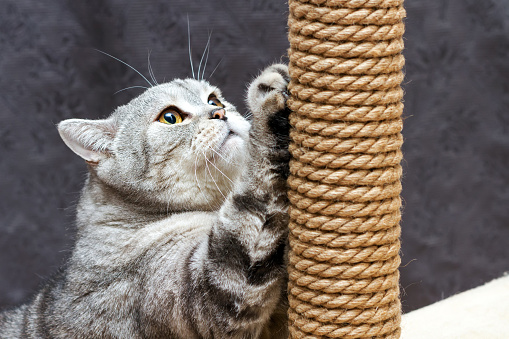
Scratching their claws is probably the most “cat” thing we are used to watch our feline friends do. Scratching is not only a fun way for your cat to destroy your furniture but also an effective way to sharpen his/her claws and mark his/her territory (through specific scents in the pads). Having said that, it is important for you to provide scratching toys for your kitty. They will also help him/her exercise and reduce stress.
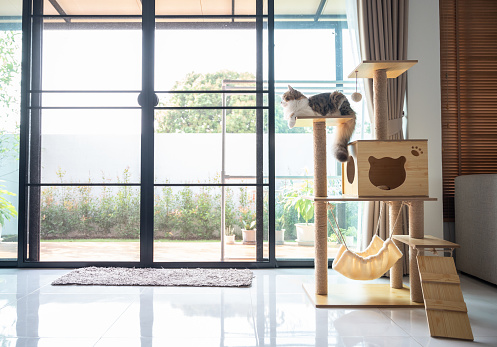
Cats love exploring their home, especially raised places that may look to you hard to access. Raised points provide a good view to all areas in the room, bringing a feeling of safety and also nurturing the natural curiosity of our paw friends. We would recommend that you remove any fragile items from shelves and place them in a safe place. You may want to consider getting a climbing tree or providing your cat with a “hand-made” climbing option, i.e. make some sort of bridge between the shelves or stack them up.
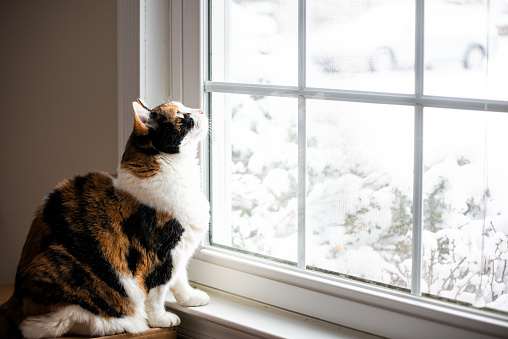
Unfortunately, there are many incidents with cats running out from an open window and getting lost or injured while trying to get out. Securing windows with a net or a bar might be a good option to prevent unwanted situations from occurring. Arranging a comfortable and safe place near a window where your cat can observe the world or just lie in the sun, will be appreciated by your paw friend. Cats are considered sun-seekers as they receive energy from the sun that otherwise they will need to generate themselves.
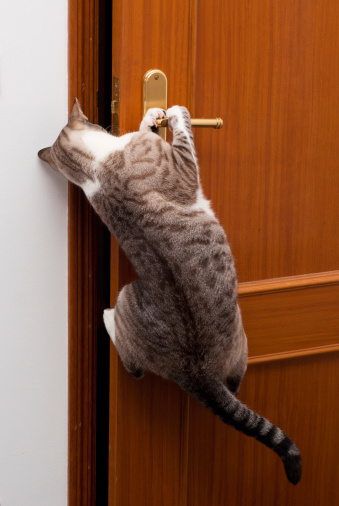
There are several tips we would like to in regard to “doors” as part of a cat’s environment.
You should be prepared for your cat to attempt to sneak in/out at any time, to check what is on the other side of the door, and indulge his/her curiosity. Considering that, you should always be very careful when opening and closing to avoid accidentally injuring your kitty.
You should keep in mind that both cats and dogs typically do not stand being locked in a room. You should provide your cat with open areas to explore as much as possible. However, always check the front door and make sure that you have not left it open.
It is common for our paw friends, both cats, and dogs, to look for ways to open closed doors. If you want to ensure that your kitty won’t be able to open a door and eventually break its handle during his/her attempts, you should consider replacing the handle with a doorknob.
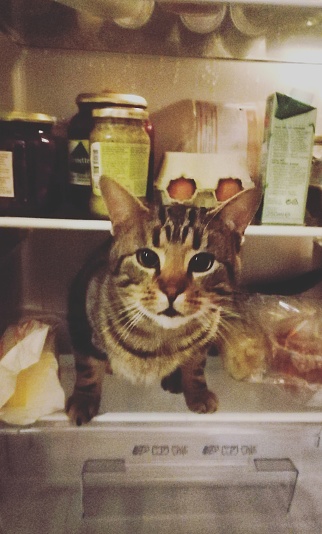
Talking about “safety”, there might be many items in your home, that are potentially dangerous for your cat, i.e. sharp objects, cleaners, hot surfaces, cookers, and even plants, that could be toxic for your kitty. Also, you should be careful when using the washing machine and opening/closing the fridge, as your kitty may have gotten inside without you noticing. Make sure that your home is as safe for your cat as possible.
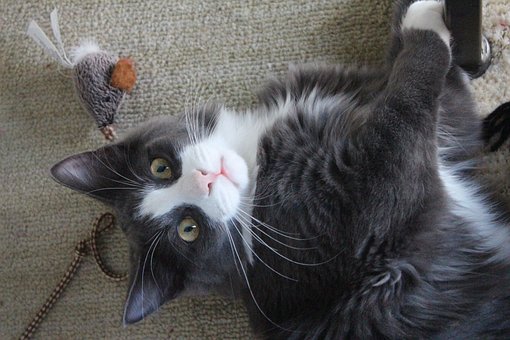
Puzzles and chasing toys help our feline friends indulge their natural instincts to hunt and catch their prey and stay physically and mentally fit. Providing your cat with toys will stimulate him/her to show his/her natural instincts and channel these in a non-destructive way for your home. That would be the best option for both you and your cat.
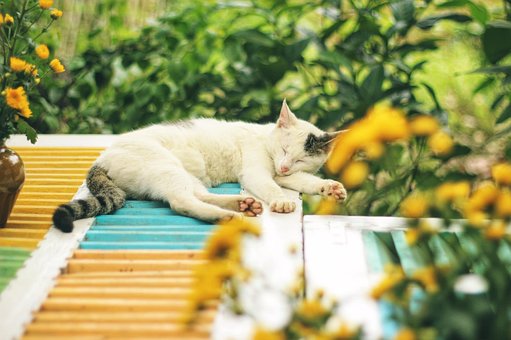
If your cat is highly motivated to spend time outdoors, you may want to try to set up a safe outdoor space for him/her. Many owners install cat flaps, to ease their kitty’s access to the garden/backyard. If this is also your case, you should make sure that the outdoor area your cat enjoys visiting, is also safe. Putting a fence, avoiding toxic fertilizers/pesticides or other products dangerous to your cats, and regularly providing parasite control against fleas and ticks are among the actions you can take to create a safe outdoor environment for your cat.
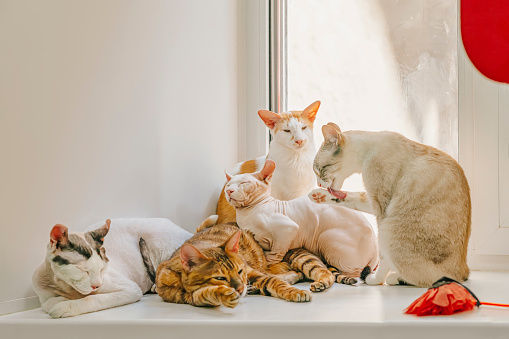
This point refers to your cat’s personality and social skills. Some cats do not have problems sharing their living space with other pets or people, while others have strong territorial instincts. You should not force your cat to spend time with you, your family members, or pets in the household, if this would not suit his/her personality. Though socialization plays an important role in our pets’ lives, we should always be cautious in our actions and not make them feel insecure and uncomfortable. Otherwise, we may lose their trust. If you have multiple cats, you should make sure that you have supplies for each of them, such as separate food/water bowls, litter boxes, many toys, and bedding options.